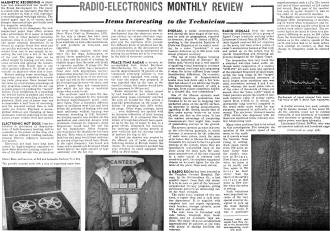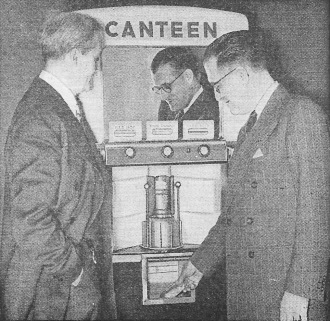|
March 1946 Radio-Craft
 [Table of Contents] [Table of Contents]
Wax nostalgic about and learn from the history of early electronics.
See articles from Radio-Craft,
published 1929 - 1953. All copyrights are hereby acknowledged.
|
EME (earth-moon-earth)
amateur radio enthusiasts will be interested in reading this report of the first
known instance of bouncing a radio signal off the surface of the moon and then receiving
it. The event was reported in the April 1946 issue of Radio Craft magazine.
A highly modified "SCR-271" radar set was used, and operated at the standard frequency
of 111.6 MHz. Aside from customizing the pulse width and repetition rate, an
adjustment to the receiver was necessary to account for the Doppler shift of the
return frequency due the the moon's motion relative to the earth. Handling Doppler
frequency shifts was necessary in the course of normal operation, but the moon,
depending on its position in the sky, could be moving as fast as 750 miles per hour
- faster than any airplanes of the era. Also presented this month was the first
commercially operating RF food heater, built by the
Automatic Canteen Company
(1953 lawsuit). Working
with General Electric, their engineers experimented with more than a thousand frequencies,
power levels, and mechanical configurations to arrive at a solution which properly
heated hot dogs and buns together.
Radio-Electronics Monthly Review
 Electronic Hot Dogs, long distributed
to spectators at demonstrations of high-frequency heating, will be available to
the public at the drop of a dime into an ordinary vending machine, General Electric
engineers announced last month. Electronic Hot Dogs, long distributed
to spectators at demonstrations of high-frequency heating, will be available to
the public at the drop of a dime into an ordinary vending machine, General Electric
engineers announced last month.
Electronic hot dogs have long been cooked by high-frequency engineers to show
what dielectric heating could do - one of the first set-ups was pictured on the
cover of the Gernsback magazine Short Wave Craft in November, 1933. So far only
a chosen few have been privileged to taste them. Now they will be as available as
such other mechanically sold products as Coca-Cola and cigarettes.
The electronic canteen, which will serve the hot dogs, hamburgers, or grilled
cheese sandwiches at the drop of a dime and the push of a button, is slightly larger
than the usual soft drink or cigarette machine. It plugs into the regular 117-volt
outlet, has a decorative front door with appropriate mirror; push-button selectors
for choice of food; a glass window in front of the electronic unit and coil so the
customer can see his food getting the heat - by radio; and below a glass door and
compartment into which the hot dog or sandwich drops when ready to eat.

Messrs. Baker and Leverone, of G-E and Automatic Canteen, try
a dog.
The oscillator used to heat the canteen items is operated by two specially developed
high-frequency power oscillator tubes. Over a thousand different types of oscillators
were built and tried before the problem of heating rolls and meat uniformly, without
burning was overcome, according to G.E. transmitter division experts who worked
out the mechanical and electrical designs with Automatic Canteen Co. engineers.
Some frequencies would heat the roll but not the frankfurter. Other frequencies
would heat the frankfurter but burn the roll. Then when it looked as though both
bun and meat would heat uniformly, one end of the bun would burn. Finally the right
frequency was found and tubes and a special coil developed which would deliver the
right amount of heat uniformly over the hot dog.
It should not be construed from this development that the electronic stove is
just around the corner, electronic engineers hasten to explain. The canteen grill
and the electronic stove present two different kinds of problems and the accomplishments
in the development of the former should not be interpreted as solving the problems
yet to be overcome in the field of electronic cooking.
Peace-Time Radar is already an accomplished fact, stated Raytheon
Manufacturing Co., in a report last month. Approximately 75 percent of the transports
returning soldiers to this country were equipped with radar at the time the report
was prepared. It was expected that by the time of the report's release, the number
would have been increased to 100 percent.
Radar eliminates the delays caused by bad weather or poor visibility. A pencil-sharp
beam constantly searches the area all around the ship, giving a map-like presentation
on the radar indicator of anything that falls within its range. Other ships, icebergs,
buoys ... even driftwood, are spotted with an accurate indication of their bearing
and distance. It is estimated that the return of troops has already been speeded
up by the use of radar. It has, to a great extent, eliminated the necessity for
reducing speed during periods of poor visibility and for waiting outside of harbors
for fog to lift.
At least one disaster was averted by the efficient use of radar during and following
storms in British waters this winter. No troop-transport accident has ever occurred
on ships equipped with SO-1 or SO-8 radar.

Oscillograph of signal returned from moon. Tall trace at left
is direct from transmitter.

Antenna which sent signals from New Jersey to the deceptively
near-appearing moon and back.
Radio Signals from the moon were reported January 10 by a group
of Signal Corps scientists working under Lieutenant-Colonel John H. DeWitt. The
radio signals received did not originate on the moon, but were return pulses of
radar transmissions beamed at that body and picked up on the return trip by special
transmitting and receiving apparatus designed by the Signal Corps.
The transmitter was very much like a standard war-time radar outfit. Although
many components of a regular "SCR-271" set were used, and operated at the standard
frequency of 111.6 megacycles, the long range of the "target" made certain deviations
necessary. A much longer pulse repetition rate was used, somewhere between 3 and
5 seconds, whereas the usual pulse rate is of the order of thousands of times per
second. Also the "pulse width" which in radar parlance means the length of time
each separate pulse of energy exists, varied from 1/10th to 1/2 second, an enormously
long interval compared to the usual radar pulse width for war purposes, measured
in millionths of a second. The electronic transmit-receive (TR) switch was dispensed
with for these low repetition rates, ordinary electric relays being used.
Many other problems had to be solved in this investigation. For example, the
question of the relative speed of the moon to the earth as it travels across the
heavens from rising to setting. Such speed varies from 750 miles an hour faster
than the earth's rotation at Belmar, New Jersey, to zero when the moon is at its
zenith, and then again to 750 miles an hour slower than the speed of the earth's
surface at that point in New Jersey when the moon is setting.
Such variations were important because of the very special receiver designed
to pick up the weak signals from the moon. It was a quadruple superheterodyne with
4 i.f.'s. The lowest and last of these operated at 200 cycles per second. Band pass
of the receiver was only 60 cycles. Sensitivity was in the order of 0.01 microvolt
absolute.
The highly selective receiver made the Doppler effect (lengthening or shortening
of waves when transmitter and receiver are moving rapidly away from or toward each
other) important. The receiver had to be tuned at times to a frequency differing
as much as 200 cycles from the transmitted frequency. Calculations as to the relative
speeds of the earth and moon had to be made before each attempt at contact, so that
the change in frequency could be allowed for.
A double antenna was used, containing 64 dipoles instead of the usual 32. As
the antenna could not be rotated vertically, it was necessary to transmit near moonrise
or moonset. Peak transmitter power was three kilowatts.
Lieutenant-Colonel DeWitt, who was an amateur radioist and broadcast engineer
before the war, admits having made attempts to radio the moon as an amateur experimenter
in 1940. A true ham, he is still not entirely satisfied with the greatest DX ever
attained by one of the fraternity, and is already looking forward to working the
moon on 'phone! Army scientists, he said, hope to increase their transmitter's power
so that it could be modulated by voice. We should like to be able to say 'Hello'
and hear the moon say 'Hello' back... I hope the moon doesn't answer, 'Goodby',"
he declared.
Posted
|













